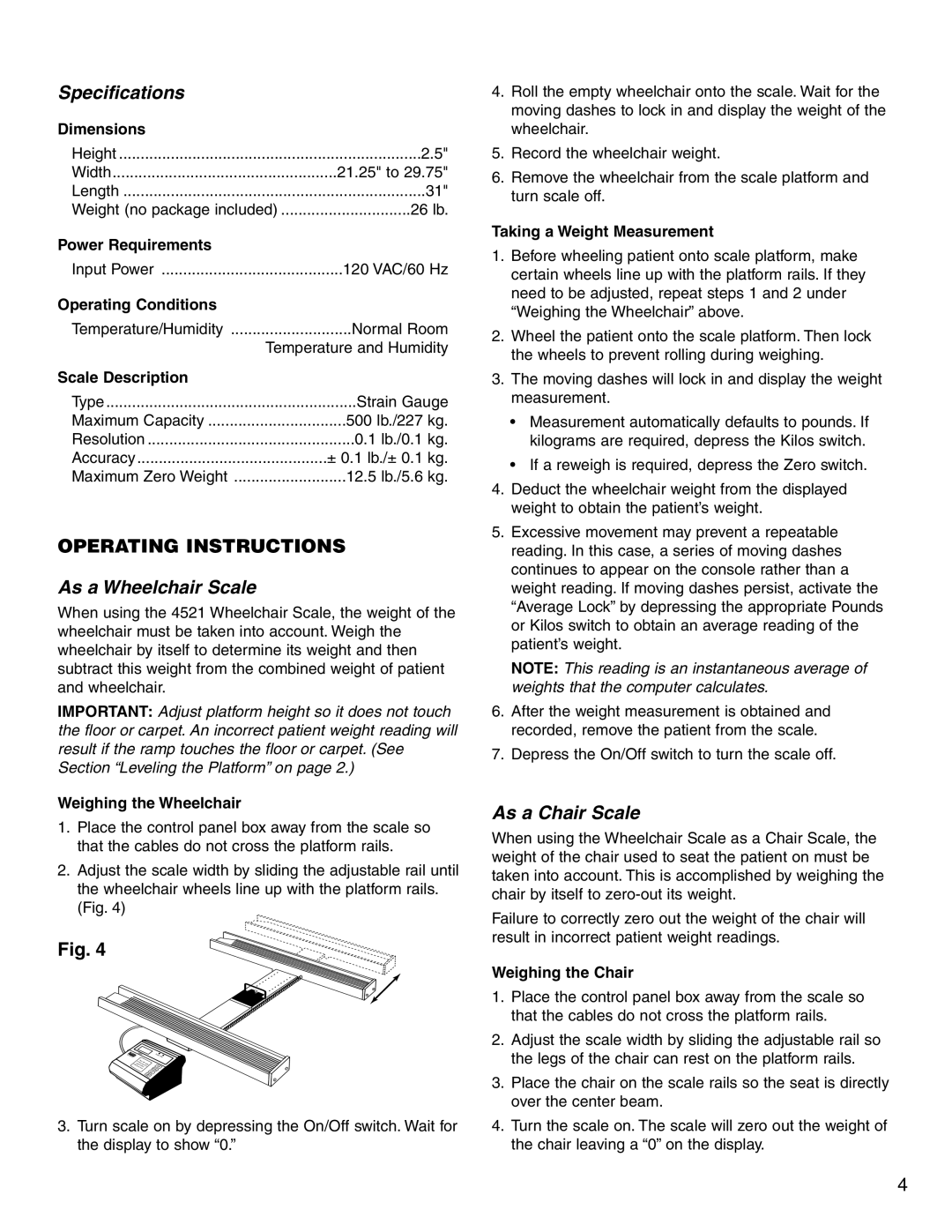
Specifications
Dimensions |
|
Height | 2.5" |
Width | 21.25" to 29.75" |
Length | 31" |
Weight (no package included) | 26 lb. |
Power Requirements |
|
Input Power | 120 VAC/60 Hz |
Operating Conditions |
|
Temperature/Humidity | Normal Room |
Temperature and Humidity | |
Scale Description |
|
Type | Strain Gauge |
Maximum Capacity | 500 lb./227 kg. |
Resolution | 0.1 lb./0.1 kg. |
Accuracy | ± 0.1 lb./± 0.1 kg. |
Maximum Zero Weight | 12.5 lb./5.6 kg. |
OPERATING INSTRUCTIONS
As a Wheelchair Scale
When using the 4521 Wheelchair Scale, the weight of the wheelchair must be taken into account. Weigh the wheelchair by itself to determine its weight and then subtract this weight from the combined weight of patient and wheelchair.
IMPORTANT: Adjust platform height so it does not touch the floor or carpet. An incorrect patient weight reading will result if the ramp touches the floor or carpet. (See Section “Leveling the Platform” on page 2.)
Weighing the Wheelchair
1.Place the control panel box away from the scale so that the cables do not cross the platform rails.
2.Adjust the scale width by sliding the adjustable rail until the wheelchair wheels line up with the platform rails. (Fig. 4)
Fig. 4
3.Turn scale on by depressing the On/Off switch. Wait for the display to show “0.”
4.Roll the empty wheelchair onto the scale. Wait for the moving dashes to lock in and display the weight of the wheelchair.
5.Record the wheelchair weight.
6.Remove the wheelchair from the scale platform and turn scale off.
Taking a Weight Measurement
1.Before wheeling patient onto scale platform, make certain wheels line up with the platform rails. If they need to be adjusted, repeat steps 1 and 2 under “Weighing the Wheelchair” above.
2.Wheel the patient onto the scale platform. Then lock the wheels to prevent rolling during weighing.
3.The moving dashes will lock in and display the weight measurement.
•Measurement automatically defaults to pounds. If kilograms are required, depress the Kilos switch.
•If a reweigh is required, depress the Zero switch.
4.Deduct the wheelchair weight from the displayed weight to obtain the patient’s weight.
5.Excessive movement may prevent a repeatable reading. In this case, a series of moving dashes continues to appear on the console rather than a weight reading. If moving dashes persist, activate the “Average Lock” by depressing the appropriate Pounds or Kilos switch to obtain an average reading of the patient’s weight.
NOTE: This reading is an instantaneous average of weights that the computer calculates.
6.After the weight measurement is obtained and recorded, remove the patient from the scale.
7.Depress the On/Off switch to turn the scale off.
As a Chair Scale
When using the Wheelchair Scale as a Chair Scale, the weight of the chair used to seat the patient on must be taken into account. This is accomplished by weighing the chair by itself to
Failure to correctly zero out the weight of the chair will result in incorrect patient weight readings.
Weighing the Chair
1.Place the control panel box away from the scale so that the cables do not cross the platform rails.
2.Adjust the scale width by sliding the adjustable rail so the legs of the chair can rest on the platform rails.
3.Place the chair on the scale rails so the seat is directly over the center beam.
4.Turn the scale on. The scale will zero out the weight of the chair leaving a “0” on the display.
4
